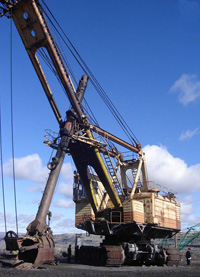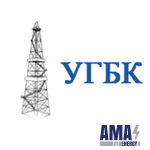ECG mining Excavators
The excavation park, which is now in service with many mining enterprises, almost entirely consists of traditional machines that were manufactured at the Uralmash plant, Izhorskiy Zavod Production Association (at the moment this enterprise is called the United Machine-Building Plants, Uralmash- Izhora "), the enterprise" Krastyazhmash ", at the factories of the closed joint-stock company" NKMZ ", the open joint-stock company" Donetskgormash ", as well as the open joint-stock company" Azovmash ".
The excavator fleet is very worn out and consists of outdated equipment, some excavators have already crossed the thirty-year age limit, however, despite this they continue to work. Such long-term operation is possible only thanks to the traditional constructive design of these excavators, which are simple in design and metal-intensive.
The parametric series of domestic single-bucket excavators were developed by Centrogiproshakht back in 1967. The main parameter was the bucket capacity in cubic meters. It was planned to create 2 types of excavators: ECG - career crawler excavators with a bucket capacity of 2-20 cubic meters and EVG - overhead tracked excavators with a bucket capacity of 15-100 cubic meters. At the moment, the designation of excavators is changing and depends on the internal standards of the manufacturer.
ECG excavators are electric full-rotary devices (there are modifications with the primary engine on diesel fuel) with standard or extended equipment (excavators of this type are marked with the additional letters US and Y). The main functions of excavators of this type are - the development and loading of rock mass into the receiving tanks of cars and other special units at the excavator standing level or above this level. Rocks of the first and second categories are developed without prior loosening using blasting, rocks of the third category and higher are developed exclusively after loosening.
The breeds are classified according to the Unified mining standards for open cast mining for mining organizations. Depending on the climate, excavators are manufactured in the “U” version (moderate, temperature ± 0.5 ° C); “HL” (resistant to cold, temperature changes from +40 to –60 ° С; “С” (north) - from +40 to –50 ° C; and “Т” (tropical) - from +55 to –20 ° C.
At the moment, the most common excavator is EKG-5A, which is produced by the Uralmash plant . The standard ECG-5A model with a rack-and-pinion head has been mass-produced since 1980. For many design features, the standard ECG-5A model is unified with the ECG-4,6B model, which was produced by the same factory earlier. The excavator has proved itself to be a sufficiently reliable and adapted machine for working in various mining and geological conditions. To date, excavators from this manufacturer continue to be used intensively. It should be noted the high level of maintainability of this model, the design of ECG-5A units is well known to repair organizations and services in the regions, it should also be noted that there is no shortage of spare parts and accessories.
The electric drive ECG-5A is made according to the generator – engine system with control from magnetic amplifiers. The Uralmash plant also offers an ECG-5D model with primary diesel engines, which is often necessary in mining operations in the case of remoteness of power lines and the lack of the possibility of their supply to the place of work. The key metal structures of this excavator are made of low-alloy steel 10HSND, the elements of the bucket are made of wear-resistant steel 110G13L, and the components of power transmission are made of alloyed steels.
One of the possible models of the excavator is a model that is equipped with a bucket with built-in pneumatic impact teeth ( ECG-5V ), which are automatically switched on in the event of an increase in resistance during digging. According to representatives of the plant, this system can develop fractured rocks, as well as coals of small and medium strength, without using an explosion for their preliminary loosening.
ECG-5A-Us is another ECG-5A model with elongated linear characteristics of working equipment. This modification is designed to work out high ledges and can be used in the process of loading into dump trucks with a lifting capacity of 75 to 110 tons.
The EKG-8I excavator of the Izhora plant and its EKG-4U and EKG-6.3US models rightfully occupy the second place in terms of prevalence in the mining industry. Since 1987, the Izhora plant has discontinued the production of ECG-12.5 and ECG-8I models and has begun production of new models of excavators with other parameters based on ECG-15 and ECG-10 .
Models based on ECG-10 are ECG-5U and ECG-8US with extended working equipment, ECG-10M is equipped with a widened bucket with a capacity of 11.5 cubic meters and excellent bucket filling (this model is designed for use in coal mines). EKG-10R is equipped with a bucket with a capacity of 8 cubic meters and has an increased lifting force of up to 110 tons, as well as an in-line lifting winch. Models ECG-15 - ECG-12.5US , as well as the model ECG-8U have elongated working equipment. The electric drive on the current ECG-10 and ECG-15 and their various modifications is made according to the generator-engine system.
Absolutely all mining excavators manufactured by the Izhora plant have a set of unified solutions in the device, which have managed to prove themselves in a good way. Such solutions are: articulated, which is unloaded from torsion boom, cable head, single-beam handle. Also, these solutions include a separate drive for each track, sectional body, as well as the through unification of the standard model and elongated modifications thanks to the double pulley block of the standard model's bucket suspension and so on. A two-section boom device helps prevent bending loads on the hull, similar to how it happens with excavators manufactured by the Uralmash plant , although a single-beam round cross-section handle is slightly worse for developing rock faces that were not blown well enough. In case of uneven impact on the cutting edge of the bucket from oversized during scooping, the handle, without having a strong fixation in the saddle bearing, can rotate around the axis, which significantly complicates the filling of the bucket. 
A relatively fresh and promising model of ECG-12 (14) manufactured by the Uralmash plant with rack pressure has already received modifications of ECG-12V with pneumatic impact teeth, as well as ECG-9US with elongated working equipment. The strong double-girder handle of the excavator is excellent for developing complex rock in the faces with large parts of the rock mass. The main mechanisms of the excavator are equipped with an individually adjustable DC drive, as well as a digital control system, the drive operates on a generator-motor system with thyristor excitation.
A powerful ECG-20A of the Uralmash plant completes the range of mining cable excavators manufactured by a domestic manufacturer. This excavator is equipped with a rack head and a two-beam handle, EKG-20A is designed to work with dump trucks with a carrying capacity of at least 170 tons. The electric drive in this model operates on a thyristor converter – motor system.
The last two models do not apply to machines of widespread use, they were produced only a couple of units.
From the famous flagships of the domestic excavator construction EVG-15 and EVG-35.65 at the moment there are only glorious memories and rare photos. Overburden mechanical shovels can no longer satisfy the current mining and geological conditions in quarries. High-performance excavating and transporting complexes using rotary excavators or large single-bucket excavators in combination with large-capacity dump trucks are now used there. To a large extent, replacing the stripping mechanical shovels of EVG steel with powerful walking draglines.
In the marking of a walking excavator (ES) with dragline equipment, the numbers that stand to the point indicate the bucket capacity in m3, and the numbers after the point indicate the length of the boom in meters. The advantages of dragline are large working radii, the ability to work with both upper and lower scooping. Dragline is necessary in the process of transshipment of rocks, it is used in overburden operations in the case of a transportless development system, in dumps, rocks with low bearing capacity, as well as in the process of laying trenches and so on. The most common dragline model is ESh-10.70A and its version ESh-13.50 manufactured by NKMZ. This model was produced in series, from 1971 to 1991 inclusive. During this time, more than 500 machines were manufactured, the lion's share of which is still working at the mining enterprises of the Russian Federation.
For 20 years, NKMZ has been manufacturing ESh-11.70 (a modified version of ESh-14.50). The distinctive qualities of this model are an 11 m3 bucket, trellised boom, cementation and grinding of gears in gearboxes of some mechanisms, as well as a progressive control system and so on. ESh-10.70 and ESh-11.70 and their codification versions are used in many enterprises of the coal and ore industries, in the extraction of building and cement raw materials, and so on.
The main overburden excavator at the current powerful open pits and in open pits is ESh-20.90 with a trihedral cable-stayed boom, which is manufactured at the Uralmash plant (OMZ). This model has been produced since 1981, ES-20.90 replaced ES-15.90A . It is equipped with a hydraulic walking mechanism, has the same structure of lifting and traction winches. The electric drive operates on a generator-motor system with thyristor excitation, however, it should be noted that the plant can offer other options: a thyristor converter – motor, as well as a frequency converter – asynchronous motor.
In the near future, mining units will need new units with functional linear characteristics, more productive ones that can satisfy the demands of mining and geological conditions, which are becoming more complicated all the time. Firstly, these are mechanical shovels with a bucket with a capacity of 20 cubic meters or more, which are necessary for working with super-heavy dump trucks, draglines with an arrow longer than 120 m and a bucket with a capacity of 40 cubic meters or more. Manufacturers are now ready to offer fresh and interesting models.
United engineering plants are the only domestic manufacturers of powerful mining excavation equipment, offering a fairly wide selection of mining excavators, as well as mechanical shovels and draglines.
Buckrus International Inc. is the world leader in mining excavators. with subsidiaries Marion and Ransomes-Rapier, and P&H also offers a range of draglines and mechanical shovels. The structure of excavators produced by these organizations is different. There are various options for the working equipment of mechanical shovels, including improved pressure and handle systems. New dragline bucket suspension systems are also being developed that allow controlling the progress of unloading and filling the bucket during the entire trajectory of its movement. Modern electronic key drive control systems are used. Enterprise developers are not afraid to change the usual assembly of machines, thereby creating more advanced products.
The only manufacturer of strong open pit hydraulic excavators in the Russian Federation is still the OMZ Open Joint-Stock Company (Uralmash-Izhora Group). The enterprise has accumulated considerable experience in creating machines of this type. We can safely say that competitive hydraulic equipment can and must be produced at the plants of this association. Moreover, there is a certain tendency on the world market to switch to the production of powerful and high-performance hydraulic excavators, which can increase the intensity of work.

